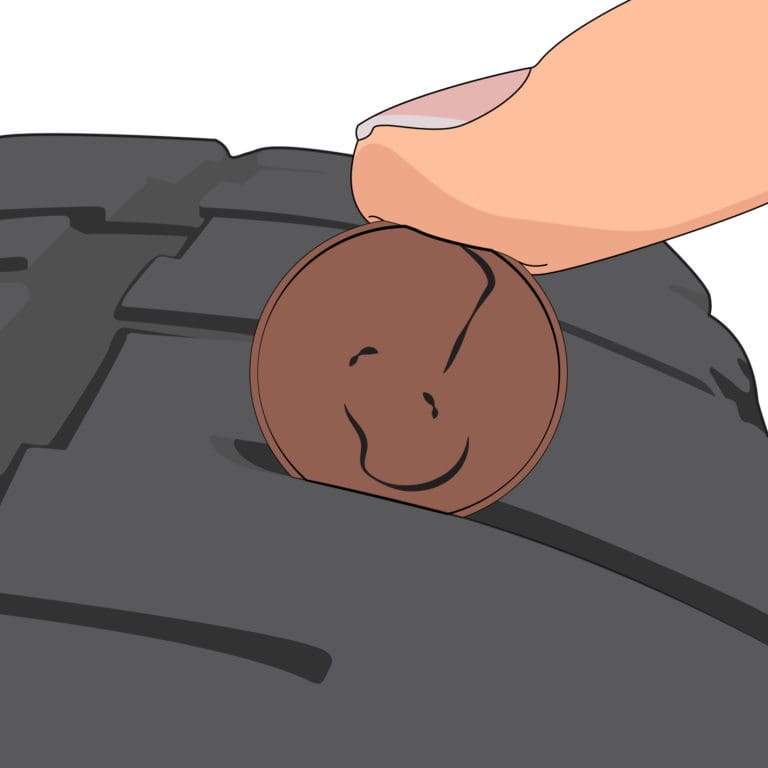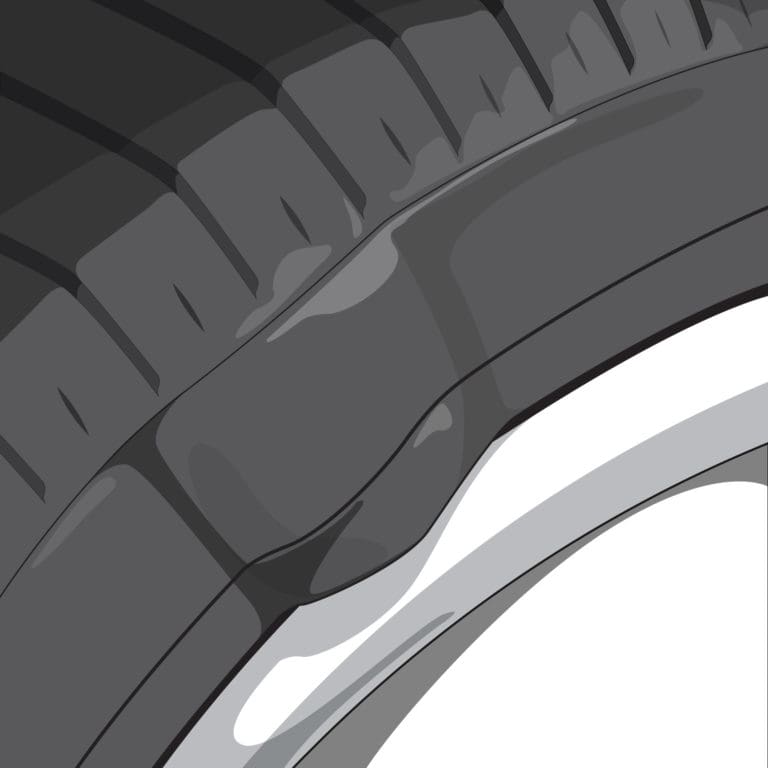How do I read my tire's wear pattern?
Tire wear can be a good source of information about the condition of the other parts of your trailer. Irregular tire wear patterns are often caused by the need for a little maintenance.
Your trailer’s tires help carry the weight of your cargo, and in order to do so safely, it’s necessary to inspect them often for wear and replace them as needed. Waiting too long to replace your trailer’s tires can lead to a number of issues and even create dangerous situations, so we want to make sure you know how to spot the signs that your tires need to be changed.
You should be inspecting your tires before you use your trailer, every time. As you inspect your tires, keep in mind the following areas that need to be inspected for indications that your tires should be replaced.
TIRE TREAD
The tread on your trailer’s tires provide the gripping action and traction needed to keep your trailer from slipping and sliding on the road, driveways, and more. Look at tire treads for signs of uneven wear patterns. As a general rule of thumb, your tires should be replaced when the tread is worn down to 2/32 of an inch.
Tires do have built-in tread wear indicators to help you realize when it is time to replace them. The indicators are the raised sections with intermittent spacing in the bottom of the tread grooves. When these indicators appear even with the outside of the tread, it’s time to replace your trailer’s tires. You can also check this by placing a penny in the tread depth with Lincoln’s head upside down and facing you. If you can see the top of his head, you need to buy new tires. Remember to include your trailer’s spare tire in your regular inspections!

CRACKS, PUNCTURES, AND FOREIGN OBJECTS
Cracks, punctures, and foreign objects can create spaces that allow air to escape from your tires. If you don’t catch it soon enough, any of these could lead to a blowout or worse. Remove foreign objects as soon as you notice them wedged in your tire tread to prevent further damage. If you notice a crack or if your tire is punctured, it may be repairable by plugging the hole and patching the area inside the tire that surrounds the hole, depending on the location. If this doesn’t resolve the issue, or if your tire’s sidewall has been punctured, it will need to be replaced. Remember, any attempt to repair trailer tires should be done by a tire professional.
VALVE STEM
In addition to inspecting tires for cracks, be sure to check the valve stem for cracks as well. This is important because the valve stem is used to inflate the tire. If a tire cannot be properly inflated due to cracks in the valve stem, it’s time to replace the tire.
DAMAGE OR DEFORMITIES
Keep an eye out for damage and deformities such as bulges, cuts, and flat or extremely bald spots and replace your tires if you notice any of these.

AGE
Age is also a factor to consider when determining if your trailer’s tires need to be replaced. Each tire manufacturer will likely have different recommendations on the service life of a particular type of tire, but statistics suggest the average life of a trailer tire is about five years under normal use and maintenance conditions, and that tire replacement should be considered after three years, even if the tires appear to have adequate tread depth. Consult with your tire dealer if you have questions regarding the life expectancy of your trailer’s tires.
In addition to knowing how to spot the signs that your trailer’s tires are due to be changed, it’s important to know the most common causes of trailer tire damage and avoid them to help maintain safety on the road, and extend the life of your tires and improve your vehicle’s fuel economy. Trailer tire damage is often a result of:
- Improper tire pressure.
- Excessive exposure to sunlight, moisture, and extreme temperatures.
- Trailers stored with weight on the tires.
- Excessive speed.
- Improper loading
- Exposure to high temperatures while in use.
- Sporadic use of the trailer.
- Axle issues that affect wear on the tires, such as alignment issues.
Your trailer’s tires are a key element of your trailer, and knowing when to replace them is essential to ensure your own safety, as well as the safety of your cargo and others on the road. If you have questions regarding your trailer’s tires and when to replace them, consult with your owner’s manual, your trailer dealer, or a tire professional.
Trailer Tire Wear
Tire wear can be a good source of information about the condition of the other parts of your trailer. Irregular tire wear patterns are often caused by the need for a little maintenance. Trailer tires should be inspected regularly, even when the trailer is out of service for extended periods. As a matter of fact, one of the worst things you can do to a bias ply tire is let it sit in one spot and get low on air pressure. This can cause the plies to seperate internally, or cause a crack in the sidewall. Then not long after you fully inflate the tire and put it back into service, you notice a big bubble on the sidewall or experience a blowout. (Caused by the seperation of the plies) Paying attention to the early warning signs of trouble can prevent wear that shortens tire life or indicates the need for having other parts of the trailer serviced.
Load of the trailer Try putting a load on the trailer, the check to see if axle bows. Check before and after load.
Under Inflation This is the most common problem in trailers. This type of wear usually results from consistent under inflation. When a tire is under inflated, there is too much contact with the road by the outer treads, which wear prematurely. Tire pressure should be checked with a reliable pressure gauge.
How To Read Tire Wear
The way your tires wear is a good indicator of other parts of your trailer. Abnormal wear patterns are often caused by the need for simple tire maintenance, or alignment. Tires should be inspected at every opportunity; once a week isn't too often. Learning to read the early warning ns tire life or indicates the need for having other parts of the trailer serviced. Tires should be inspected 3 ways. First, visually examine all tires; second, feel the tread by hand to detect wear such as feathering and third, check all tires
with a pocket type pressure gauge.
Over Inflation
Excessive wear at the center of the tread indicates that the air pressure in the tire is consistently too
high. The tire is riding on the center of the tread and wearing it prematurely. Many times, the
"eyeball" method of inflation (pumping the tires up until there is no bulge at the bottom) is at fault;
tire inflation pressure should always be checked with a reliable tire gauge. Occasionally, this wear
pattern can result from outrageously wide tires on narrow rims. The cure for this is to replace either
the tires or the wheels.
Under Inflation
This is the most common problem in trailers. This type of wear usually results from consistent
under inflation. When a tire is under inflated, there is too much contact with the road by the outer
treads, which wear prematurely. Tire pressure should be checked with a reliable pressure gauge.
Feathering
Feathering is a condition when the edge of each tread rib develops a slightly rounded edge on one
side and a sharp edge on the other. By running your hand over the tire, you can usually feel the
sharper edges before you'll be able to see them. The most common cause of feathering is incorrect
toe-in setting, which can be cured by having It set correctly.
One Side Wear
When an inner or outer rib wears faster than the rest of the tire, the need for wheel alignment is
indicated. There is excessive camber in the axle, causing the wheel to lean too much to the inside or
outside and putting too much load on one side of the tire. The trailer may simply need the wheels
aligned, but misalignment could be due to sagging springs, overloaded trailer or an unbalanced load on
multi axle trailers. Because load has a great affect on alignment, be sure the trailer is loaded to balance
the weight on the axle or axles. Trailer should be towed level, this is particularly important with
independent suspension trailers using torsion axles.
Cupping
Cups or scalloped dips appearing around the edge of the tread on one side or the other, almost always
indicate worn (sometimes bent) suspension parts. Adjustment of wheel alignment alone will seldom cure
the problem. Any worn component that connects the wheel to the trailer (wheel bearings, springs,
bushings, etc.) can cause this condition. Worn components should be adjusted or replaced with new
ones. The worn tire should be balanced and possibly moved to a different location on the trailer.
Occasionally, wheels that are out of balance will wear like this, but wheel imbalance usually shows up as
bald spots between the outside edges and center of the tread.
Second-rib Wear
Second-rib wear is normally found only in radial tires, and appears where the steel belts end in relation
to the tread. Normally, it can be kept to a minimum by paying careful attention to tire pressure and
frequently rotating the tires. Some tire manufacturers consider a slight amount of wear at the second rib
of a radial tire normal, but that excessive amounts of wear indicate that the tires
are too wide for the wheels. Be careful when having oversize tires installed
on narrow wheels.
Click here to download a pdf version: How do I read my tire's wear pattern?





